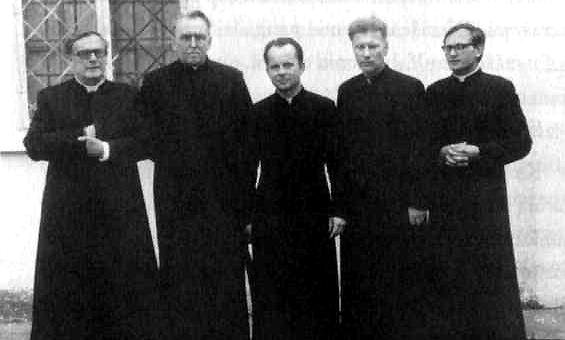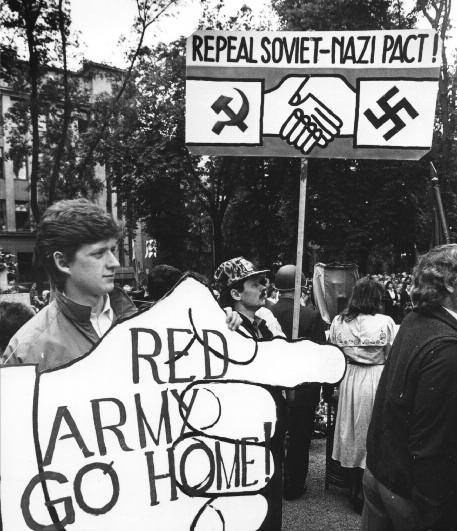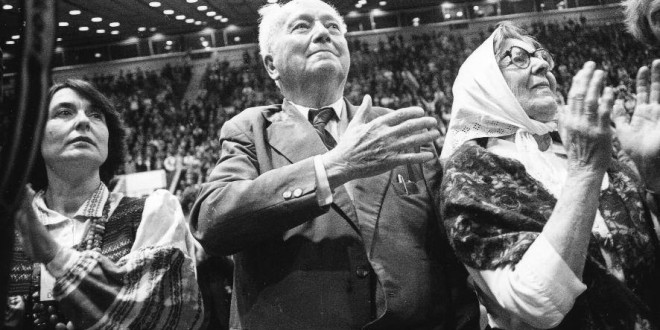By ALEKSAS VITKUS.
Time has come to celebrate the 25th Anniversary of the re-establishment of Lithuania’s independence, which was joyfully declared a quarter of a century ago in Lithuania and celebrated by Lithuanians throughout the world. Who could have believed that after 50 years of the hated occupation the dawn of freedom would arrive? Hopes of liberation by the West receded many years ago, but began to glimmer again when courageous individuals, both young and old, patriots and dissidents, realized that to win freedom they must seek it themselves. Let us now recall how the fight for freedom was waged and ultimately won.
Armed resistance to communist aggressors in Lithuania began as soon as the first Red Army units reinvaded Lithuania in the Summer of 1944. First unorganized, then slowly, evolving into well-organized units, they covered the entire country. There were individual fighting units, training camps, publications, and support from the local populace. The resistance grew focused on fighting the NKVD (or KGB) forces and local collaborators (stribai).
The partisans concentrated on undermining local communist control in the countryside, punishing collaborators and informers, while leaving cities and larger towns mainly undisturbed. This unrealistic but optimistic strategy was predicated on the belief that aid would ultimately come from the West. Energetic partisan resistance helped discourage Russian colonizers from moving to Lithuania. After the death of Stalin in 1953, many native communist leaders attempted to justify their collaboration as a means of preserving Lithuania’s cultural heritage and the Lithuanian language.

The last Communist leader, Algirda Antanas Sniečkus, Communist Party First Secretary who ruled over Lithuania from 1944 until his death in 1974, was the only Baltic native-born communist official who could possibly claim to have shown some benevolent feelings toward his native country. Sniečkus was followed by Petras Griškevičius (1974-1987). After Griškevičius’ death, Rimgaudas Songaila lasted less than a year (1987-1988) and was deposed from power.
Brazauskas, lost power as Lithuania’s independence was declared on March ll, 1990. However, Brazauskas then ran for president of independent Lithuania against Lithuania’s pre-war diplomat Stasys Lozoraitis and surprisingly was elected on November 25, 1992. Evidently, Lithuania’s voters saw in Brazauskas, an engineer and a manager, an apparent mediator with the powers in Moscow, somebody who managed to obtain for Lithuania solid infrastructure, roads, industry, all resulting in a relatively decent economy. With Brazauskas Lithuanians hoped to achieve a better deal with Moscow in future relations. Brazauskas ought not to be deemed a covert patriot, as he certainly never showed much enthusiasm for Soviet rule, nor did he, on the other hand, enthusiastically embrace Lithuania’s push for immediate independence.
The dream of achieving independence from the monolithic rule of the Soviet Union simmered throughout the 50 long years of occupation. The real struggle for human rights, however, did not begin in earnest until the 1970’s when detente gradually thawed the chill that the Cold War had cast over international relations. The Conference on Security and Cooperation in Europe (CSCE) begun in 1972 was an attempt to lessen East-West tensions and open the lines of communication. It was finalized in Helsinki on August 1, 1975, by 35 participating nations. These became known as the Helsinki Accords. The U.S. was represented by President Gerald Ford and Secretary of State Henry Kissinger. The Soviets were represented by Leonid Brezhnev and Andrei Gromyko.
Basic themes covered by the Accords were: sovereign equality, refraining from the threat or use of force, inviolability of States, peaceful settlement of disputes, non-intervention in internal affairs and respect for fundamental freedoms of thought, conscience, religion and belief. An official Committee was established to ensure ongoing compliance with the Accords. At first Brezhnev considered the Accords as a great triumph of Soviet diplomacy. Conferences in Belgrade and Madrid helped reveal to the international community that human and national rights were cruelly suppressed by the Soviet regime. The American public was still unconvinced that U.S. policy on the Baltic States would not be jeopardized by the Helsinki Accords. Neither were Lithuanians at home nor abroad fully secure that the long standing US non-recognition policy had not been compromised.
Since the first days of the occupation, members of the Catholic Church in Lithuania suffered terror, violence, violations of fundamental rights and freedoms. They resisted heroically and continuously fought for the rights and freedoms to which they were entitled. The loyal clergy concluded that an underground publication was needed not only to promote religious beliefs and values, but to document the abuses that Moscow was perpetrating against Church members. They hoped that world opinion would temper the forces of tyranny.
This underground Church thus began publishing The Chronicle of the Catholic Church in Lithuania. The first issue appeared in the Simnas parish of the Alytus district on March 19, 1972. Its founder and inspiration was a young priest, Rev. Sigitas Tamkevičius (now the Archbishop of Kaunas diocese). He was assisted by Rev. Juozas Zdebskis and a national network of lay people.
Emboldened by these and other developments, dissidents in Moscow led by Andrei Sakharov organized the first Helsinki group in 1976. Its goal was to demand that the Soviet government adhere to the agreed-upon human rights principles declared in Helsinki. In Lithuania a similar Helsinki group was established to act openly and within the limits of prevailing law. Among its principal leaders were dissident Viktoras Petkus and poet Tomas Venclova. Since foreign correspondents were not allowed in Lithuania, the Lithuanian Helsinki Group called a press conference in Moscow. It was held on December 1, 1976, and the foreign press had its first opportunity to encounter Lithuanian human rights activists. Soviet reaction was not long in coming. Venclova lost his citizenship and had to move to the U.S. Petkus was imprisoned. The group incorporated long-time human rights activist Balys Gajauskas, who had spent many years in Siberia. Soon others joined as well.

Although eventually the Lithuanian Helsinki Group ceased to exist, its work and moral form continued to inspire the people of Lithuania. In November 1978 the Catholic Committee for the Defense of Believers’ Rights was founded by Father Alfonsas Svarinskas, Father Sigitas Tamkevicius, and Father Juozas Zdebskis, among others.
Other events challenged Soviet rule. In 1970 a Lithuanian seaman Simas Kudirka, radio operator, made a dramatic leap from the deck of a Soviet fish processing vessel off the Massachusetts shore. He announced his wish to defect, but confusion over U.S. policy on defection prevented nearby U.S. Coast Guard cutter Vigilant from providing Kudirka with asylum. As the crew of the Vigilant looked on helplessly, the Russian officers beat and bound Kudirka, and dragged him back to his own ship. This became a national scandal and Western media provided ongoing coverage. Later it was determined that Kudirka, through his mother, had US citizenship. At President Ford’s intervention, Kudirka and his family were freed and came to the US.
In May 1972, a high school student Romas Kalanta immolated himself in the square facing the National Theater in Kaunas. It was the same theatre where in 1940 the puppet communist “people’s parliament” petitioned the Soviet Union to admit Lithuania as one of the soviet republics. His death provoked the largest post-war demonstrations in Lithuania. Kalanta became a symbol of the Lithuanian resistance to Soviet rule..
On April 26,1986 in a small town of Pripyat on the Dnieper river, in Ukraine, the Chernobyl nuclear reactor ruptured in a series of explosions. The resulting fire sent a plume of highly radioactive steam into the atmosphere and over an extensive geographical area in Ukraine and Belarus. The plume also drifted over large parts of Russia and western Europe, including Lithuania. About 400,000 people had to be evacuated and resettled. Authorities sent thousands of recovery workers and soldiers to help. Some Lithuanians serving in the Red Army were called as well.
Soon it became clear that senior officials of the Communist Party had perpetrated a massive coverup that had endangered the lives of millions. By 1989 Lithuanians had concluded that only independence could save their country from such horrors in the future. The Chernobyl disaster cover-up played a major part in stimulating Baltic anger, as did the appalling treatment meted out to Baltic soldiers serving in the Soviet army, be it in Chernobyl cleanup or fighting in Afghanistan.
In Lithuania, the Soviets built the Ignalina nuclear plant near the town of Visaginas. Unit 1 came on line in December, 1983. Unit 2 was scheduled for operation in 1986, but its commissioning was postponed for a year because of the public outrage precipitated by the Chernobyl disaster. Construction of Unit 3 was suspended in 1988, and construction of Unit 4 never started. This and Moscow’s other projects to industrialize Lithuania’s economy plus more extensive drafting of Lithuania’s young men into the Red Army fueled the movement for national independence.

Three major movements for human rights and freedom – the Catholic Chronicle, the Helsinki Group and the Committee to Defend Believers’ Rights, over time melded into the Lithuanian Freedom League (Lietuvos laisvės lyga). Its leader was another freedom fighter Antanas Terleckas. The League was founded in the Summer of 1978. Soviet authorities arrested him and sentenced him to an eight-year term. Upon returning free to Lithuania, he organized a mass meeting in Vilnius on August 23,1987, to denounce the infamous Molotov- Ribbentrop Pact of 1939.
On June 3, 1988, another initiative group of 36 dissidents/patriots founded Sąjūdis, a movement for Lithuania’s restructuring in support of Gorbachev’s Perestroika. It was not a political party, because other than the Communist Party all parties were still banned. The Lithuanian Communist Party (LCP) felt lost, in need of new blood. It fired Songaila, and in late 1988 elected Algirdas Brazauskas to lead the party. Brazauskas garnered a measure of respect by returning Vilnius Cathedral to the Church. (The Soviets had turned the Cathedral into a museum). In October 1988, Sąjūdis elected as its first Chairman Vytautas Landsbergis, a professor of music and the son of a well-known Lithuanian patriot, architect Gabrielius Žemkalnis-Landsbergis (1893-1993).
On August 23, 1989, to commemorate the 50th anniversary of the infamous Nazi-Soviet secret agreement, some two million people formed a human chain – The Baltic Way – from Vilnius through Riga to Tallinn calling for Baltic independence. The sands were shifting quickly, and more and more members of the LCP demanded to break from the Communist Party of the Soviet Union. Shortly thereafter the Supreme Soviet in Moscow acknowledged the existence of the secret protocols to the Molotov-Ribbentrop Pact which resulted in the Soviet occupation of the Baltic countries.
By the Fall of 1989, Eastern Europe had begun its liberation from Soviet rule. The Communist Party in Poland lost an election, the Hungarian Party was fragmenting, in Czechoslovakia the Velvet Revolution was sweeping the country, Communist leaders in Eastern Germany, Bulgaria and Romania were being removed, some even killed. Rumors were flying high as no one was sure what a meeting in early December, 1989, between the new U.S. President George H. W. Bush and the new head of the USSR Mikhail Gorbachev would produce. Alas, no agreements were signed.
Then Gorbachev summoned the entire Lithuanian leadership to Moscow, but his attempt to browbeat the Lithuanians failed. Brazauskas explained to Gorbachev that the LCP could not survive in Lithuania unless it distanced itself from Moscow, but Gorbachev wouldn’t buy it. He decided to see for himself and arrived in Vilnius on January 11, 1990. Sąjūdis organized a mass rally. Cathedral Square was filled to capacity with people, jamming even the side streets and chanting “Freedom! Freedom!” The organizers had invited Gorbachev to come, but he chose to face the more friendly precincts, finding very little support even there. His dramatic visit ended in failure on the very next day. The Congress of the Communist Party of Lithuania, meeting in Vilnius, declared its independence from the Communist Party of the Soviet Union. Less than a fifth of the delegates continued their allegiance to Moscow.
In February 1990, Lithuania held its first free and democratic elections since World War II. The people overwhelmingly voted for candidates endorsed by Sąjūdis. During its first assembly on March 11, 1990, the Supreme Soviet of the Lithuanian SSR changed its name to the Supreme Council of the Republic of Lithuania and elected Vytautas Landsbergis as its Chairman. The assemby then formally declared the re-establishment of the State of Lithuania. The act was approved at 10:44 p.m. by 124 members of the Council, while six abstained. When independence was declared, deputies spontaneously rose to sing the Lithuanian national anthem. Outside a crowd surged forward to tear down the Soviet insignia over the Congress’ door.
Independence was decidedly declared. The first steps were taken to the road of actual independence – the removal of foreign troops. As president Landsbergis would later assert: “We had crossed the river and burned the bridge, so we would not even be tempted to reconsider our firm decision.” Freedom was achieved
 DRAUGAS NEWS Lithuanian World Wide News in English
DRAUGAS NEWS Lithuanian World Wide News in English
